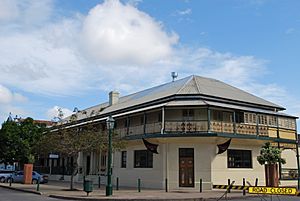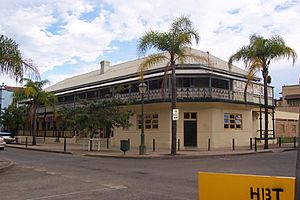Customs House Hotel, Maryborough facts for kids
Quick facts for kids Customs House Hotel, Maryborough |
|
|---|---|

Customs House Hotel, Maryborough, 2008
|
|
| Location | 116 Wharf Street, Maryborough, Fraser Coast Region, Queensland, Australia |
| Design period | 1840s - 1860s (mid-19th century) |
| Built | 1868 |
| Built for | George Gilbraith |
| Official name: Customs House Hotel | |
| Type | state heritage (built) |
| Designated | 21 October 1992 |
| Reference no. | 600715 |
| Significant period | 1860s-1950s (fabric) 1868-ongoing (historical use) |
| Significant components | furniture/fittings |
| Lua error in Module:Location_map at line 420: attempt to index field 'wikibase' (a nil value). | |
The Customs House Hotel is a very old hotel located at 116 Wharf Street in Maryborough, Australia. It was built in 1868 and is the oldest hotel still standing in the city. Because of its history and unique look, it was added to the Queensland Heritage Register on October 21, 1992. This means it's a special building that needs to be protected.
Contents
History of the Customs House Hotel
The Customs House Hotel has a long and interesting past. It was built for a man named George Galbraith in 1868.
Early Maryborough and the Hotel
The city of Maryborough wasn't always where it is today. It first started on the north side of the Mary River around 1847-1848. This was a good spot for wharves, which are docks where ships can load and unload goods. Wool from sheep farms was a very important cargo.
By 1852, the town began to move to its current location. This new spot was better for ships to sail on the river. As the town grew, Maryborough became its own municipality (like a city council) in March 1861.
When Queensland became a separate colony in 1859, Maryborough was made a port. This meant it was an official place for ships to come and go. A customs officer, Mr. Sheridan, was appointed to collect taxes on goods coming into the port. He first worked from a small room on Wharf Street.
By 1861, a special building called the Customs House was built. Two years later, a Bond Store was built next to it. This store was used to hold goods that still needed taxes paid on them.
Building the Hotel
The land where the Customs House Hotel stands was bought in 1852. In 1865, George Galbraith became a part-owner of the land closest to the Customs House. He then built the first part of the hotel in 1868. It was a two-storey brick building. We don't know who designed it.
In 1870, George Galbraith bought the land next door and made the hotel even bigger. He added more rooms upstairs and a billiard room (for playing pool) downstairs.
Galbraith owned the hotel until 1871, when John Franklin took over. Franklin had run another hotel in Maryborough before. The Customs House Hotel has had many owners since then, but it has always stayed a hotel.
When the hotel was first built, its two-storey verandah (a covered porch) had a timber railing. This was changed to the fancy cast iron railing you see today by 1894. Later, in the 1950s, the public bar area was made larger. A new roof-like structure was added over this area to provide shade.
What the Hotel Looks Like
The Customs House Hotel is a two-storey building made of brick. It sits on a corner where Wharf Street and Richmond Street meet in Maryborough. There's also a two-storey part at the back where people can stay.
The building has a rectangular shape. It stretches out more along Wharf Street, where a newer part was added that matches the old style. The corner of the building is cut off, which you can see in the shape of its sloping metal roof.
There are two-storey verandahs (covered porches) along the main sides of the building. These verandahs are held up by square timber posts. They have a decorative cast iron railing and a fancy design at the top. Some parts of the railing have been replaced with different cast iron patterns. On the Richmond Street side, you can still see horizontal timber louvre blades on the second-floor verandah.
Inside the Hotel
You can enter the public bar through a door on the cut-off corner of the building. This part has a concrete finish and a roof-like structure that sticks out for shade. It also has many windows. Inside the bar, you can still see the original wall of the building, even though some large openings have been made in it.
The main entrance for the dining and accommodation rooms is on Wharf Street. It has a double door with large windows on either side. Above the door and windows are big glass panels that say "CUSTOM HOUSE HOTEL." The entrance and windows are separated by decorative columns. Further along Wharf Street, there are many windows. Some have frosted glass, while others are older multi-pane windows.
When you step into the entrance hall, you'll see a ceiling made of pressed metal with decorative edges. There are also parts of an old wallpaper strip on the lower half of the walls. The wooden staircase has a wide, open design with turned balusters (spindles) and square newel posts (main posts) topped with acorn shapes. From this hall, you can go into the former dining and billiard rooms. These rooms have been changed quite a bit, but an old fireplace still remains.
The first floor of the hotel is mostly still in its original condition. It has a central hallway with plaster walls and decorative archways. The rooms where guests stay are accessed from this hallway. Many of these rooms still have their original furniture and fittings, including small sinks built into wooden cabinets in the corners. If a room faces the front, you can step out onto the verandah through French doors with pretty glass panes. A wide verandah at the back means all rooms have access to outdoor space.
Why the Hotel is Important
The Customs House Hotel is listed on the Queensland Heritage Register for several reasons.
A Piece of History
The hotel shows how Maryborough grew, especially near the docks and along Wharf Street. It helps us understand the history of the city.
A Beautiful Building
The hotel is a great example of a country town hotel in Queensland. It's known for being on a busy corner with two-storey verandahs on its main sides. It's also valued for its beautiful details, like the fine woodwork, the cast iron designs on the verandah, and its windows. The Customs House Hotel is an important part of the look and feel of Wharf Street.
Important to the Community
As the oldest hotel still operating in Maryborough, the Customs House Hotel is very important to the community. It has served the public for a very long time.
Images for kids



